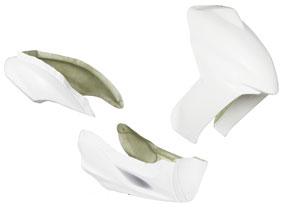http://thechemistrysideoftheforce.blogspot.com/
Among the products developed by industry and tuning kits are the most commonly used are fiberglass. It is a flexible, lightweight, durable and relatively easy to use, which has earned the reputation in these types of work.
Fiberglass is a material used in motorcycle racing fairings, and may be in supersport, superbike, formula extreme ...
This type of fairing kits are cheaper and easier to assemble, and to all a series of shrouds supersport as are all grilles, headlights and plastics can be about 20 pieces, all these are replaced by just 3 or 4 piece fiberglass kit, which are also much lighter and much easier to replace when a fall.
Fiberglass fairings for yamaha jog rr. These fairings are often used both for tuning, and for competitions scooter.
Fiberglass is also frequently used in the tuning for both motorcycles and for cars, sometimes we get bored of seeing the neighbor, who knows if for the sake of boredom or in good faith, has decided to buy the same bike that we and decided to take the first step in transforming our bike aesthetic.
Modifying a motorcycle is more aesthetically to have a different bike to the other, is something like shape our personality in our bike and try to be the best and most beautiful when we decided to take this step we have two options to the garage or do it ourselves by decantaría I personally do it myself, is something that when finished will fill us with pride and satisfaction.
hints you some examples:
Here you have a little help if you dare to do it yourselves
SECURITY MEASURES
You need to take protective measures not to hurt us both to make work more comfortable.
For that matter, the measures most are minimum:
1. Work in a ventilated place better and more appropriately illuminated.
2. Use over-ca-ri-lla.
3. Gloves.
4. Glasses pro-tec-to-flush.
You have to keep in mind that going to cause a chemical reaction that will give off harmful gases and, above all, stinky ... In addition, the fiberglass fabric may cause allergic skin reactions especially annoying, as if you would have done a great a Ortigal.
MATERIAL
Where is pur-chase?
The material can be found at any hardware store, car spare parts or boating, because fiberglass is widely used for helmets ... It is even possible that at any drug store or paint store ... Also in stores is possible because construction the resin-free fiberglass insulation is used to heat homes. But at this point I return to emphasize what not to confuse the fiberglass putty of glass ...
The presentations that I know are two: either in kit form it comes in 1 square meter of fabric and resin and catalyst to work, leaving about 10 euros or so separate out the fabric about 4 euros meters and about 20 liter of polyester resin ...
Material to make a mold:
I like wood but has the drawback of the songs ... I know that the polystyrene is also used and, in fact, the majority use this material because it can get more easily rounded, but I do not like it because I find it very difficult to achieve perfect symmetry, they have to go to rough estimates ... may be that the solution is to make the plywood mold and fill the edges with plaster or even silicon, giving a rounded shape with round support of any element (eg a can of soda) ... To make fuel tanks, which are usually made of fiber although I am not supporter of anything, I think that the best way is the plaster giving way with a balloon filled with water ...
1. Wax or oil the mold more easily take off the piece.
2. Fiberglass Fabric
3. Polyester resin which is sold in cans with a catalyst that comes in a separate tube. characteristics can vary from manufacturer to manufacturer and there are more or less rapid resins to react ... I am personally very upset because the slow, contrary to what may seem bad to me are correct ...
TOOLS
1. Keyhole saw
2. Drill
3. Spatula
4. Sandpaper.
PHASES
1. Construction of a mold
2. Make a piece using the mold
3. Part Polishing
4. Finish.
Let's look at each of these phases.
Construction of a mold
It is a matter of manual work of cole-gio. The complexity of this mold and is up to you.
To make the mold you can use almost any material: from polietireno (Styrofoam) to plaster through wood.
The mold should be on the outside of the piece: that way when desmoldeis, the piece will almost polished. If you are perfectionists and you want the inside out I also perfect, you have to make a mold and a counter-mold, so that the piece is the result of glass fiber is the filling between the sandwich between the mold and the counter . Obviously, the countermould shall provide the thickness you want in the resulting piece.
Personally and for those who do not have much experience in this, I recommend plywood and glue Imedi transparent, it is easy to use and enables you to effortlessly symmetries. The plaster has the advantage of allowing more rounded, but is more laborious because you have to make a mold prior.
You have to take into account that the fiberglass has the advantage that it sticks to itself, so that once made a piece tengais later and following the same procedure you can add fiberglass parts such as brackets, hooks, etc. .
Make a piece using the mold
Part Manufacturing
Once we have the mold (and the counter if any) comes the fun part of the case ... The first thing to do is cut the fiberglass cloth so that it covers the entire surface you like it come out. The more layers do them, the thicker the piece will end. With two layers is usually sufficient.
Then untareis areas where the fiberglass will be in contact with the mold generously with anything slimy and greasy, as well, when both desmoldeis not stick to the mold piece, otherwise difficult to see unmold you succeed.
When you have all this preparation, is the climax. We'll take a plastic container (a glass or bottle of water to which you've previously cut off the narrow part. Typically, polyester resin boat say they first put the resin into the mold, then fiberglass. Personally I I do the opposite: put the material into the mold (it is often difficult because it runs) and then pour the resin ... Let each choose his method but the end result will be the same ... I do so because the conditions I now I will explain ... For glass resin from acting, it is necessary to add the catalyst and mix well ... The catalyst is what causes the chemical reaction that then I will tell you ... The only problem is that this reaction occurs in an indefinite time: depending on environmental conditions, especially temperature, occurs before or after ... is not instantaneous, but when it starts no one can stop ... Some say that it has to do with a room temperature of 25 degrees they say which is the ideal temperature for the reaction and fiberglass stiffness gain by crystallization ... Personally I disagree deeply about it: maybe that works with people accustomed to working with fiberglass usually ...
Personally, I have been working with the polyester resin at 5 degrees and the reaction has usually only has given me more time to distribute it ... We take the plastic container, pour the polyester resin, we add the catalyst in the proportion indicated by the manufacturer and the mix with a stick or a spatula until we see that the catalyst (usually a bright color: red) disappears in the honey-colored resin ... ... It costs nothing and immediately pour all that content onto the fiberglass evenly in pan with a spatula, reaching the entire surface of the part ... but without rushing Hurry: we normally about ten minutes of leeway to conclude this operation ... It's like when they divide the oil in a skillet to cover the entire area ... you will see how glass material seems to dissolve like a sugar in milk ... Once divided, if you have done the countermould You place it ... And if not, well played ... wait 10-15 minutes have made a mixture of resin with the catalyst will begin to hear a few clicks: is the chemical reaction will begin to smoke ... it is not simply the result of this reaction that gives off much heat and water vapor and a stink Qui no wiggle you: if you do it indoors, I assure you it will cast those emanations respireis ... No ... wait you half an hour.
If the piece is too large, you may incorporate appropriate stiffness win metálicospara nerves or to place the hooks ... It is at this stage that you can incorporate ...
Part Polishing
Before removing from pan that was used to, with the coping saw, cut all the edges along the edge of the mold ... you will realize that it is easy ... with a jigsaw and drill holes that you can make you feel like it ...
Unmold ... you have the piece I made ...
Finish
To clean the piece and free of oil residue from when I was in the mold, use solvent degreased ... Once the piece, you can sand it to finish polishing ... and is ready to give the primer and paint. Keep in mind that the color of the piece will come out white, but that can change the resin tinting fiberglass color you like before mixing with the catalyst ...
And that's it ... Now you can you manufacture your own airplane fuselage.






No hay comentarios:
Publicar un comentario